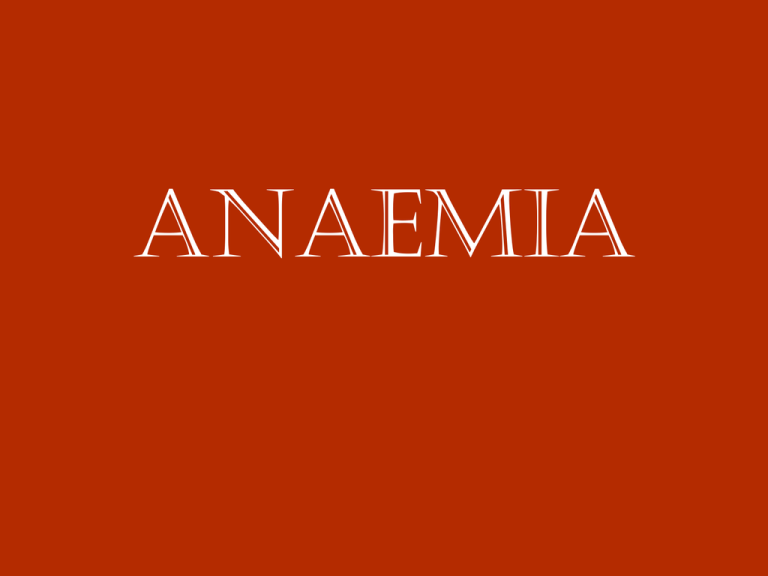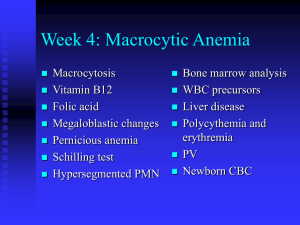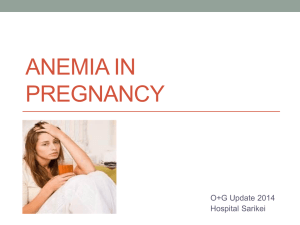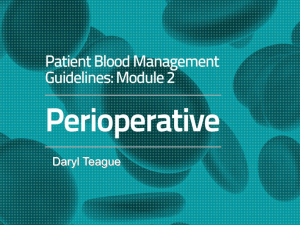Hemato Lecture1
advertisement

ANAEMIA • The main function of the red blood cells is oxygen transport. Hence a functional definition of anaemia is 'a state in which the circulating red-cell mass is insufficient to meet the oxygen requirements of the tissues'. • However, many compensatory mechanisms can be brought into play to restore the oxygen supply to the vital centers and therefore in clinical practice this definition is of limited value. • For this reason anaemia is usually defined as 'a reduction of the haemoglobin concentration, red-cell count, or hematocrit to below normal levels'. • It has been extremely difficult to establish a normal range of haematological values, and hence the definition of anaemia usually involves the adoption of rather arbitrary criteria. For example, the World Health Organization recommends that anaemia should be considered to exist in adults whose haemoglobin levels are lower than 13 g/dl (males) or 12 g/dl (females). DEFINITIONS IN HAEMATOLOGY Mean corpuscular volume (MCV) Haematocrit Red cells count N = 80 – 96 μ Mean corpuscular haemaglobin (MCH) = Haemaglobin x 10 Red cells count N = 27 – 33 pg Mean corpuscular = haemaglobin concentration (MHCH) Haemaglobin x 10 Haematocrit N = 32 – 35 g/dL = Clinical features Symptoms (all non - specific): – fatigue – headaches – faintness – breathlessness – angina of effort – intermitent claudication – palpitations Signs: 1. Non / specific signs include: – pallor – tachycardia – a full pulse – systolic flow murmur – cardiac failure – ankle oedema – rarely papilloedema and retinal haemorrhage in an acute bleed 2. Specific signs: – koilonychia – spoon-shape nails seen in iron deficiency anaemia – jaundice – haemolytic anaemia – bone deformities – thalassemia major – leg ulcers – sickle cell disease Classification: 1. Hypochromic microcytic with low mean corpuscular volume (MCV) 2. Normochromic normocytic with a normal MCV 3. Macrocytic with a high MCV Special investigations: – bone marrow aspiration from the sternum or posterior illiac crest is performed to: – confirm a diagnostic made from peripheral blood count – determine the cellularity of the marrow – determine the type of erythropoiesis – determine the proportion of the various lines – see wether the marrow is unfiltrated – determine the size of the iron stores MYCROCYTIC ANAEMIA – small cells (microcytes) – low MCV (< 80 μL) – ↓ iron content –ragged normoblasts } Iron deficiency anaemia – small cells (microcytes) – low MCV (< 80 μL) – normal iron content hyperplastic } Thalassaemia Sideroblastic anaemia 1. IRON DEFICIENCY – the commonest cause of mycrocitic anaemia – the average daily diet contains 15 – 20 mg of iron, but only 10% is absorbed – absorption: duodenum and jejunum ferrous iron is absorbed better than ferric gastric acidity helps to keep iron in the ferrous state and soluble in the upper gut – transport in the blood: transported in the plasma bound to transferin, beta globuline synthesized in the liver – iron stores – in the tissues as ferritin and haemosiderin (1000 – 1500 mg) – requirements: each day 0.5 – 1 mg of iron are lost in the faeces, urine and sweat menstruating women lose 0.7 mg iron / day of menstruation pregnancy and groth ↑ iron demand CAUSES OF IRON DEFICIENCY 1. Poor intake 2. Decreased absorption 3. Increased demands 4. Blood loss The commonest cause of iron deficiency: Blood lost from G.I. tract Menstruation • The average American diet contains 10–15 mg of iron per day. About 10% of this amount is absorbed. Absorption occurs in the stomach, duodenum, and upper jejunum. • Dietary iron present as heme is efficiently absorbed (10–20%) but non heme iron less so (1–5%), largely because of interference by phosphates, tannins and other food constituents. • Small amounts of iron—approximately 1 mg/d— are normally lost through exfoliation of skin and mucosal cells. • There is no physiologic mechanism for increasing normal body iron losses. • Menstrual blood loss plays a major role in iron metabolism. The average monthly menstrual blood loss is approximately 50 mL or about 0.7 mg/d. However, menstrual blood loss may be five times the average. • To maintain adequate iron stores, women with heavy menstrual losses must absorb 3–4 mg of iron from the diet each day. • This strains the upper limit of what may reasonably be absorbed and women with menorrhagia of this degree will almost always become iron deficient without iron supplementation. • By far the most important cause of iron deficiency anemia is blood loss, especially gastrointestinal blood loss. • Prolonged aspirin use, or the use of other anti-inflammatory drugs, may cause it even without a documented structural lesion. • Iron deficiency demands a search for a source of gastrointestinal bleeding if other sites of blood loss (menorrhagia, other uterine bleeding and repeated blood donations) are excluded. • Chronic hemoglobinuria may lead to iron deficiency since iron is lost in the urine, but this is uncommon. • Traumatic hemolysis due to a prosthetic cardiac valve and other causes of intravascular hemolysis (eg, paroxysmal nocturnal hemoglobinuria) should also be considered. • Frequent blood donors may also be at risk for iron deficiency. Symptoms and Signs • -anemia syndrome • s/s due to iron defficiecy • s/s due to disease which cause chronic blood lose • Severe deficiency causes skin and mucosal changes, including a smooth tongue, brittle nails, and cheilosis. • Dysphagia because of the formation of esophageal webs (Plummer–Vinson syndrome) also occurs. Clinical features • In humans, unusual syndromes of food craving (pica) have been recorded and appear to respond to iron supplementation: this includes craving for soils and the ingestion of silica-rich earths as a cult practice in black populations of the Southern United States— geophagia. • Pagophagia (ice-craving) combined with the abnormal taste preferences of pregnancy may account for the bizarre food craving that constitutes part of the folklore of pregnancy. • Severe iron deficiency may occasionally be associated with splenomegaly and the signs of underlying disease include peripheral oedema (hypoalbuminaemia associated with massive hookworm infection) and oronasal telangiectasia associated with Osler– Rendu–Weber disease (hereditary haemorrhagic telangiectasia). Clinical features: – brittle nails – spoon – shaped nails (koilonychia) – atrophy of the papillae of the tongue – angular stomatitis – brittle hair – dysphagia and glossitis (plummer – Vinson or Paterson Brown Kelly syndrome) – parotid gland enlargement, splenomegaly and failure to grow Smooth, bald, burning tongue; Iron deficiency anemia Cancer of uterus Gastric cancer/ colonic cancer PeptIc ulcer investigations: –Ht, Hb, RBC low ; teiculocyte low –the red cells are microcytic (MCV < 80 fL) and hypochromic (MCH < 27 pg) – poikilocytosis (variation in shape) and anisocytosis (variation in size) – target cells – hypersegmentation of polymorphs – serum iron falls – iron blinding capacity ↑ – bone marrow – erythroid hyperplasia with ragged normoblasts – ring sideroblast other investigations: – the G.I. tract - endoscopy Poikilocytosis is a term which indicates that red cells of abnormal shape are present on the blood film. Of itself it is fairly non-specific. Some particular types of poikilocyte are very informative, however. Bone marrow in iron deficiency Iron deficiency develops in stages • The first is depletion of iron stores. At this point, there is anemia and no change in red blood cell size. The serum ferritin will become abnormally low. A ferritin value less than 12 mcg/L is a highly reliable indicator of iron deficiency. Bone marrow biopsy for evaluation of iron stores is now rarely performed because of intraobserver variation in its interpretation. • After iron stores have been depleted, red blood cell formation will continue with deficient supplies of iron. Serum iron values decline to less than 30 mcg/dL and transferrin levels rise, leading to transferring saturation of less than 15%. • In the early stages, the MCV remains normal. Subsequently, the MCV falls and the blood smear shows hypochromic microcytic cells (see blood smear). • With further progression, anisocytosis (variations in red blood cell size) and poikilocytosis (variation in shape of red cells) develop. • Severe iron deficiency will produce a bizarre peripheral blood smear, with severely hypochromic cells, target cells, hypochromic pencil-shaped cells and occasionally small numbers of nucleated red blood cells. The platelet count is commonly increased. Differential Diagnosis • Other causes of microcytic anemia include anemia of chronic disease, thalassemia and sideroblastic anemia. • Anemia of chronic disease is characterized by normal or increased iron stores in the bone marrow and a normal or elevated ferritin level; the serum iron is low, often drastically so, and the total iron-binding capacity (TIBC) is either normal or low. • Thalassemia produces a greater degree of microcytosis for any given level of anemia than does iron deficiency. Red blood cell morphology on the peripheral smear is abnormal earlier in the course of thalassemia. Iron Deficiency Anemia Essentials of Diagnosis • Serum ferritin < 12 mcg/L. • Caused by bleeding unless proved otherwise. • Responds to iron therapy. 2. sideroblastic anaemia Classification: A. Congenital: – “X” linked disease – transmitted by females B. Acquired: – primary or idiopathic – secondary: drugs alcohol lead myeloproliferative disorders leukaemias secondary carcinoma other systemic disorders (connective tissue disease) • The sideroblastic anemias are a heterogeneous group of disorders in which hemoglobin synthesis is reduced because of failure to incorporate heme into protoporphyrin to form hemoglobin. • Iron accumulates, particularly in the mitochondria. • A Prussian blue stain of the bone marrow will reveal ringed sideroblasts, cells with iron deposits encircling the red cell nucleus. • The disorder is usually acquired. Sometimes it represents a stage in evolution of a generalized bone marrow disorder (myelodysplasia) that may ultimately terminate in acute leukemia. • Other causes include chronic alcoholism and lead poisoning. • Patients have no specific clinical features other than those related to anemia. • The anemia is usually moderate, with hematocrits of 20–30%, but transfusions may occasionally be required. • Although the MCV is usually normal or slightly increased, it may occasionally be low, leading to confusion with iron deficiency. • The peripheral blood smear characteristically shows a dimorphic population of red blood cells, one normal and one hypochromic. • In cases of lead poisoning, coarse basophilic stippling of the red cells is seen. • The diagnosis is made by examination of the bone marrow. • Characteristically, there is marked erythroid hyperplasia, a sign of ineffective erythropoiesis (expansion of the erythroid compartment of the bone marrow that does not result in the production of reticulocytes in the peripheral blood). • The iron stain of the bone marrow shows a generalized increase in iron stores and the presence of ringed sideroblasts. • Other characteristic laboratory features include a high serum iron and a high transferrin saturation. • In lead poisoning, serum lead levels will be elevated. 3.thalassaemia Deficiency in the synthesis of the globin chains of haemoglobin in addition, the accumulation of abnormal chains within the red cell leads to its early destruction. The severity of the thalassaemia will depend on the amount of the haemoglobin A2 and F present. Clinically β-thalassaemia can be divided into: – thalassaemia major, with severe anaemia – intermedia, with moderate anaemia rarely requiring transfusion – minor, the symptomless heterozygous carrier state symptoms: – failure to thrive – intermittent infection – severe anaemia – extramedullary haemopoiesis → hepatosplenomegaly and bone expansion thalassaemic facies investigation: – blood count: moderate to severe anaemia (↓MCV, MCH↓) reticulocyte ↑ white cells and platelets = N – blood film: hypochromic and microcytic picture Howell – Jolly bodies – high ferritin levels – haemoglobin electrophoresis (HbF ↑; HbA absent) β-Thalassaemia trait (minor) – asymptomatic – no anaemia, red cells hypochromic and microcytic α-Thalassaemia – two main form: deletion of only alpha chain gene deletion of both alpha chain genes → no alpha chains are produced Thalassemia major Thalassemia minor Differential Diagnosis • Mild forms of thalassemia must be differentiated from iron deficiency. • Compared to iron deficiency anemia, patients with thalassemia have a lower MCV, a more normal red blood count and a more abnormal peripheral blood smear at modest levels of anemia. Iron studies are normal. • Severe forms of thalassemia may be confused with other hemoglobinopathies. • The diagnosis is made by hemoglobin electrophoresis. The Thalassemias Essentials of Diagnosis • Microcytosis out of proportion to the degree of anemia. • Positive family history or lifelong personal history of microcytic anemia. • Abnormal red blood cell morphology with microcytes, acanthocytes, and target cells. • In -thalassemia, elevated levels of hemoglobin A2 or F. Anaemia of chronic disorders (ACD) • This is the rather unsatisfactory phrase used to cover the most common of the normochromic, normocytic anaemias, namely, those found in association with chronic infection, all forms of inflammatory diseases, and in malignant disease. It is very important for clinicians to be able to identify the main features of this type of anaemia. • Although it may be extremely mild and asymptomatic, the presence of this blood picture should always alert the clinician to the possibility of there being a serious underlying disease. General Considerations • Many chronic systemic diseases are associated with mild or moderate anemia. • Common causes include chronic infection or inflammation, cancer and liver disease. • The anemia of chronic renal failure is somewhat different in pathophysiology, involving reduced production of erythropoietin and is usually more severe. Pathogenesis • The precise mechanism of the anaemia of chronic disorders is still not understood. Several different pathological processes that occur in response to inflammation conspire to cause a defective proliferation of red cell progenitors. In addition, at least in some cases, there may be a mild haemolytic component. • The most constant feature of ACD is a low serum iron level despite adequate iron stores in the reticuloendothelial elements of the bone marrow. This abnormal accumulation of iron in the storage cells, together with a low serum iron level in the blood, suggests that there is a block in the release of iron to the developing red cell precursors. This phenomenon may be observed within 24 h after major surgery, for example. There is also a reduced concentration of transferrin, and turnover studies suggest that this reflects a decreased rate of production. Clinical and laboratory findings • The anaemia of chronic disorders is usually mild. In patients with severe inflammation the haematocrit may fall to levels at which symptoms are experienced. • Although the anaemia is usually normocytic and normochromic there may be mild hypochromia with a slight reduction in the MCH and MCV, particularly in children. • Occasionally there may be marked microcytosis. Microcytosis should prompt consideration of concomitant iron deficiency, especially in patients who might have gastrointestinal bleeding, for example individuals with inflammatory bowel disease or rheumatoid arthritis on aspirin. • The reticulocyte count is in the normal range. • The clinical features are those of the causative condition. The diagnosis should be suspected in patients with known chronic diseases; it is confirmed by the findings of low serum iron, low TIBC and normal or increased serum ferritin. • In cases of significant anemia, coexistent iron deficiency or folic acid deficiency should be suspected. • Decreased dietary intake of folate or iron is common in these ill patients, and many will also have ongoing gastrointestinal blood losses. • Patients undergoing hemodialysis regularly lose both iron and folate during dialysis. Anemia of Chronic Disease Essentials of Diagnosis • Anemia, normocytic or microcytic. • Normal or increased iron stores. • Underlying chronic disease. Megaloblastic anaemias • The megaloblastic anaemias are a group of disorders characterized by a macrocytic anaemia and distinctive morphological abnormalities of the developing haemopoietic cells in the bone marrow. In severe cases, the anaemia may be associated with leucopenia and thrombocytopenia. • Megaloblastic anaemia arises because of inhibition of DNA synthesis in the bone marrow, usually due to deficiency of one or other of two water-soluble B vitamins, vitamin B 12 (B12, cobalamin) or folate. B12 deficiency may also cause a severe neuropathy but whether this occurs with folate deficiency is controversial. In a minority of cases, megaloblastic anaemia arises because of a disturbance of DNA synthesis due to a drug or a congenital or acquired biochemical defect that causes a disturbance of B 12 or folate metabolism or affects DNA synthesis independent of B12 or folate. Macrocytic anaemia The presence in the bone marrow of erytroblasts with delayed nuclear maturation because of defective DNA synthesis (megaloblasts). Occurs in: – vitamin B12 deficiency – folic acid deficiency – diseritropoetic anaemia Haematological values: – anaemia – MCV > 96 fL – blood film (peripheral): macrocytes and hypersegmented polymorphs – neutropenia – thrombocytopenia Pathology • There is a gastritis in which all layers of the body and fundus of the stomach are atrophied with loss of normal gastric glands, mucosal architecture and absence of parietal and chief cells, but mucous cells lining the gastric pits are well preserved. • An infiltrate of plasma cells and lymphocytes with an excess of CD8 cells occurs and intestinal metaplasia may be present. • The antral mucosa is remarkably well preserved except in hypogammaglobulinaemia and, like the fundus, shows an increased number of gastrin-secreting cells. Clinical features • The general features of megaloblastic anaemia are similar, whatever the underlying cause. Particular clinical features may point to the underlying disease, whethe pernicious anaemia or some other cause. • In pernicious anaemia, the anaemia usually develops gradually, perhaps over several years, and symptoms may not occur until it is severe. • The most common complaints are due to the anaemia, while loss of mental and physical drive, numbness, or difficulty in walking suggest neuropathy. Clinical features • Psychiatric disturbances are common and range from mild neurosis to severe organic dementia. They may occur in the absence of anaemia or macrocytosis. • Mild jaundice is frequent. Loss of appetite and weight, indigestion, and episodic diarrhoea are frequent. • An intercurrent infection may precipitate severe anaemia and thus symptoms. • Older patients may present with congestive heart failure. • In a few patients, bruising due to thrombocytopenia is marked. • On the other hand, many patients are diagnosed because a routine blood test is made. Clinical features • The typical patient with pernicious anaemia has fair hair (prematurely grey), with blue eyes, and wide cheekbones. • Physical signs, if present, are those of anaemia, perhaps with mild jaundice, giving the patient a so-called lemonyellow tint. • A few patients with either B 12 or folate deficiency develop a widespread brown pigmentation, affecting nail beds and skin creases particularly, but not mucous membranes, which is reversible with the appropriate therapy. • The biochemical basis for this is not clear, nor for the depigmentation that also occurs rarely. Clinical features • The tongue may be red, smooth, and shiny, occasionally with ulcers. • A mild pyrexia up to 38°C is common in patients with moderate to severe anaemia. • The liver may be enlarged while the cardiovascular system shows changes due to anaemia. • Patients with pernicious anaemia may also have features of an associated disorder on presentation, most commonly myxoedema. Other thyroid disorders, vitiligo, carcinoma of the stomach, Addison's disease and hypoparathyroidism, may precede, occur simultaneously with or follow the onset of the anaemia. vitamin b12 (Addison – Biermer anaemia) – average daily diet 5 – 30 μg B12 –average adult stores 1000 μg – liver –absorption and transport: gut → binder complex (R binder + B12) → intrinsec factor (glycoprotein from the gastric juice) Transcobalamin Ileum → → → → → → → → → → Marrow Pernicious anaemia (Addison – Biermer) affect: – particularly nordic people: fair – haired; blue – eyed. –association with other autoimmune diseases: thyroid disease, Addison’s disease, vitiligo – higher incidence of gastric carcinoma Causes of vitamin b12 deficiency: – low dietary intake (vegans) – impaired absorption: A. stomach (gastrectomy) B. small bowel: – coeliac disease – tropical sprue – bacterial overgrowth – ileal disease or resection C. pancreas: – chronic pancreatic disease – Zollinger – Ellison syndrome D. miscellaneous and rare: – fish tape worm (diphyllobothrium latum) – congenital deficiency: – intrinsec factor – transcobalamin III – nitrous oxide (inactivates B12) Partial gastrectomy • Iron deficiency usually accounts for the anaemia that occurs in up to half of subjects after this operation. • Subnormal serum B 12 levels develop in about 18 per cent of patients from about 2 years postoperatively. About 6 per cent develop megaloblastic anaemia due to the deficiency. • In most of these patients, malabsorption of B 12 is due to an abnormal jejunal flora. • The exact incidence of B 12 deficiency depends mainly on the size of the remnant, which tends to be smaller if the operation is subtotal and the peptic ulcer gastric rather than duodenal. • Vagotomy and pyloroplasty is not a cause of B 12 deficiency. Clinical features: 1. Anaemic syndrome 2. Neurological syndromes: Peripheral neuropathy progressively involving posterior and lateral columns of the spinal cord: – symmetrical paraesthesia in the fingers and toes – loss of vibration sense and proprioception – progressive weakness and ataxia – paraplegia Mental changes: – somnolence – irritability – psychosis – dementia the • Peripheral nerves are usually affected first, and patients complain initially of paresthesias. • The posterior columns next become impaired and patients complain of difficulty with balance. • In more advanced cases, cerebral function may be altered as well and on occasion dementia and other neuropsychiatric changes may precede hematologic changes. • Neurologic examination may reveal decreased vibration and position sense but is more commonly normal in early stages of the disease. 3. Digestive syndrome: – glossitis (red sore tongue) – angular stomatitis – hepatosplenomegaly – gastric atrophy and achlorhydria 4. Others: – skin – lemon-yellow tint due to hyperbilirubinaemia – heart – failure – fever • The megaloblastic state also produces changes in mucosal cells, leading to glossitis, as well as other vague gastrointestinal disturbances such as anorexia and diarrhea. • Patients are usually pale and may be mildly icteric. Investigations: – peripheral blood film shows features of megaloblastic anaemia: ↓ reticulocytes – the serum bilirubin ↑ (uncojugated) – bone marrow → megaloblastic erythropoiesis – the Schilling test (a radioactive dose of B12 is given orally and the total body activity is measured), B12 LEVEL LOW – G.I. investigations → endoscopy • The megaloblastic state produces an anemia of variable severity that on occasion may be very severe. The MCV is usually strikingly elevated, between 110 and 140 fL. However, it is possible to have vitamin B12 deficiency with a normal MCV. Occasionally, the normal MCV may be explained by coexistent thalassemia or iron deficiency, but in other cases the reason is obscure. • The peripheral blood smear is usually strikingly abnormal, with anisocytosis and poikilocytosis. A characteristic finding is the macro-ovalocyte, but numerous other abnormal shapes are usually seen . The neutrophils are hypersegmented . Typical features include a mean lobe count greater than four or the finding of six-lobed neutrophils. • The reticulocyte count is reduced. Because vitamin B12 deficiency affects all hematopoietic cell lines, in severe cases the white blood cell count and the platelet count are reduced and pancytopenia is present. • Bone marrow morphology is characteristically abnormal. • Marked erythroid hyperplasia is present as a response to defective red blood cell production (ineffective erythropoiesis). • Megaloblastic changes in the erythroid series include abnormally large cell size and asynchronous maturation of the nucleus and cytoplasm—ie, cytoplasmic maturation continues while impaired DNA synthesis causes retarded nuclear development. • In the myeloid series, giant metamyelocytes are characteristically seen. Bone marrow pernicious anaemia • The diagnosis of vitamin B12 deficiency is made by finding an abnormally low vitamin B12 (cobalamin) serum level. • Whereas the normal vitamin B12 level is > 240 pg/mL, most patients with overt vitamin B12 deficiency will have serum levels < 170 pg/mL, with symptomatic patients usually having levels < 100 pg/mL. A level of 170–240 pg/mL is borderline. • When the serum level of vitamin B12 is borderline, the diagnosis is best confirmed by finding an elevated level of serum methylmalonic acid (> 1000 nmol/L). • However, elevated levels of serum methylmalonic acid can be due to renal insufficiency. Differential Diagnosis • Vitamin B12 deficiency should be differentiated from folic acid deficiency, the other common cause of megaloblastic anemia, in which red blood cell folate is low while vitamin B12 levels are normal. • The distinction between vitamin B12 deficiency and myelodysplasia (the other common cause of macrocytic anemia with abnormal morphology) is based on the characteristic morphology and the low vitamin B12 and elevated methylmalonic acid levels. Vitamin B12 Deficiency Essentials of Diagnosis • Macrocytic anemia. • Macro-ovalocytes and hypersegmented neutrophils on peripheral blood smear. • Serum vitamin B12 level less than 100 pg/mL. Folic acid Daily requirement 100 μg Causes of folate deficiency: – poor intake: – old age – poor social conditions – starvation – alcohol excess – poor intake due to anorexia: – G.I. disease (partial gastrectomy, coeliac disease, Crohn’s disease, cancer) – excess utilization causes A. Physiological: pregnancy lactation prematurity B. Pathological: haemolysis malignant disease inflammatory disease metabolic disease haemolysis – malabsorption – antifolate drugs • By far the most common cause of folate deficiency is inadequate dietary intake. • Alcoholic or anorectic patients, persons who do not eat fresh fruits and vegetables, and those who overcook their food are candidates for folate deficiency. • Reduced folate absorption is rarely seen, since absorption occurs from the entire gastrointestinal tract. However, drugs such as phenytoin, trimethoprimsulfamethoxazole, or sulfasalazine may interfere with folate absorption. • Folic acid requirements are increased in pregnancy, hemolytic anemia and exfoliative skin disease, and in these cases the increased requirements (five to ten times normal) may not be met by a normal diet. • Patients with increased folate requirements should receive supplementation with 1 mg/d of folic acid. Symptoms and Signs • The features are similar to those of vitamin B12 deficiency, with megaloblastic anemia and megaloblastic changes in mucosa. • However, there are none of the neurologic abnormalities associated with vitamin B12 deficiency. Laboratory Findings • Megaloblastic anemia is identical to anemia resulting from vitamin B12 deficiency. • However, the serum vitamin B12 level is normal. • A red blood cell folate level of less than 150 ng/mL is diagnostic of folate deficiency. Differential Diagnosis • The megaloblastic anemia of folate deficiency should be differentiated from vitamin B12 deficiency by the finding of a normal vitamin B12 level and a reduced red blood cell folate or serum folate level. • Alcoholic patients, who often have folate deficiency, may also have anemia of liver disease. This latter macrocytic anemia does not cause megaloblastic morphologic changes but rather produces target cells in the peripheral blood. • Hypothyroidism is associated with mild macrocytosis but also with pernicious anemia. Folic Acid Deficiency Essentials of Diagnosis • Macrocytic anemia. • Macro-ovalocytes and hypersegmented neutrophils on peripheral blood smear. • Normal serum vitamin B12 levels. • Reduced folate levels in red blood cells or serum. Normocytic anaemia 1. Acute blood loss 2. Aplastic anaemia 3. Anaemia of chronic disease 4. Haemolytic anaemia 1. Acute blood loss Stage I: – Hb, Ht, Rc, N or ↑ – white cells ↑ – platelets ↑ Stage II (2 – 4 days): – Hb, Ht, Rc ↓ – reticulocytosis – ↓ white cells – ↓ platelets Stage III (2 – 3 weeks): –Hb, Ht, Rc –Wc –Platelets } N 2. Aplastic anaemia Aplasia of the bone marrow with peripheral blood pancytopenia. Causes: – congenital: Fanconi’s anaemia – acquired: – chemicals, drugs, insecticides – ionizing radiation – infections: viral hepatitis measles – miscellaneous infection: tuberculosis – tyhmona – pregnancy – unknown General Considerations • Aplastic anemia is a condition of bone marrow failure that arises from injury to or abnormal expression of the stem cell. • The bone marrow becomes hypoplastic, and pancytopenia develops. • The most common pathogenesis of aplastic anemia appears to be autoimmune suppression of hematopoiesis by a T cell-mediated cellular mechanism. clinical features: – anaemia – bleeding (ecchymoses, bleeding gums and epistaxis) – infection (fungal infections) •Patients come to medical attention because of the consequences of bone marrow failure. •Anemia leads to symptoms of weakness and fatigue, neutropenia causes vulnerability to bacterial infections and thrombocytopenia results in mucosal and skin bleeding. •Physical examination may reveal signs of pallor, purpura, and petechiae. •Other abnormalities such as hepatosplenomegaly, lymphadenopathy, or bone tenderness should not be present, and their presence should lead to questioning the diagnosis. investigations: – elevated serum iron – low haemoglobin – white cell – count 500 / mmc – platelet 20,000 / mmc – reticulocytes virtual absent – hypocellular or aplastic bone marrow Aplastic Anemia Essentials of Diagnosis • Pancytopenia. • No abnormal cells seen. • Hypocellular bone marrow. 3. Haemolytic anaemia The red cells normally survives about 120 days, but in haemolysis the cell survival times are considerably shortened. Causes of haemolytic anaemia: A. Inherited: 1. red cell membrane defect: – hereditary spherocytosis – hereditary eliptocytosis 2. haemoglobin abnormalities: – thalassaemia – sickle cell disease 3. metabolic defects: – glucose 6 phosphate dehydrogenize deficiency – pyruvate kinase deficiency (Causes of haemolytic anaemia) B. Acquired: 1. immune: – autoimmune – isoimmune (Rh or ABO incompatibility) 2. non-immune: – membrane defects: paroxysmal nocturnal haemoglobinuria, liver disease, renal disease – mechanical: damaged vessels, valve prosthesis, march haemoglobinuria 3. miscellaneous: – infections – drugs and chemicals – hypersplenism site of haemolysis: 1. Intravascular – red cells are rapidly destroyed within the circulation, haemoglobin is liberated; 2. Extravascular – red cells are removed from the circulation by macrophages in the reticuloendothelial system (liver and spleen) evidence for haemolysis: Increased red cell breakdown leads to: – iron ↑ – stercobilinogen ↑ – elevated serum bilirubin (unconjugated) – excess urinary urobilinogen – reduced plasma haptoglobin – abnormal red cell fragments in peripheral blood Increased red cell production leads to: – reticulocytosis – erythroid hyperplasia of the bone marrow clinical findings: – skin – jaundice – splenomegaly – abdominal pain (infarction or acute sequestration as in sickle syndromes) – gall stones – growth impaired (e.g. spherocytosis) – ulcers on the leg – dark urine (in haemolytic crises) – black in pmn – septic necrosis of the bone (sickle sdr.) – papillary necrosis affecting the kidney → haematuria (S.S.) – painful priaprism – cerebral damage Peripherical blood in hemolytic anaemia Polycythaemia Is defined as a haemoglobin level greater than 18 g/dL, a red cell count above 6x1012/L. The red cell volume is greater than 36 mL/kg in males and 32 mL/kg in females. Causes of polycythaemia Primary: – Polycythaemia vera Secondary: A. due to an appropriate increase in erythropoetin: – high altitude – lung disease – cardiovascular disease (right left shunt) – heavy smoking B. due to an inappropriate increase in erithropoetin: – renal disease, carcinoma, Wilms tumor – hepatocellular carcinoma – adrenal tumors – cerebellar haemangioblastoma – massive uterine fibroma Relative: – stress or spurious polycythaemia – dehydration – burns Policitemia vera Caused by chronic sustained proliferation of the erithroid population of the bone marrow. ↑ red cell volume ↑ blood viscosity compensated by an increase plasma volume and cardiac output Ht ↑ ↑ ↑ myocardial infarction stroke clinical findings: tiredness depression vertigo tinitus and visual disturbance hypertension angina intermitent claudication tendency to bleed itching after bath peptic ulcerations Symptoms • Most patients present with symptoms related to expanded blood volume and increased blood viscosity. • Common complaints include headache, dizziness, tinnitus, blurred vision, and fatigue. • Generalized pruritus, especially following a warm shower or bath, may be a striking symptom and is related to histamine release from the increased number of basophils present. • Patients may also initially complain of epistaxis. This is probably related to engorgement of mucosal blood vessels in combination with abnormal hemostasis due to qualitative abnormalities in platelet function. • 60% of patients are men and the median age at presentation is 60 years. Polycythemia rarely occurs in persons under age 40 years. Signs • Physical examination reveals plethora and engorged retinal veins. The spleen is palpable in 75% of cases but is nearly always enlarged when imaged. • Thrombosis is the most common complication of polycythemia vera and the major cause of morbidity and death in this disorder. Thrombosis appears to be related both to increased blood viscosity and abnormal platelet function. • Uncontrolled polycythemia leads to a very high incidence of thrombotic complications of surgery and elective surgery should be deferred until the condition has been treated. • Paradoxically, in addition to thrombosis, increased bleeding also occurs. There is a high incidence of peptic ulcer disease. investigations: ↑ Hb, ↑ Ht, ↑WBC, ↑platelets erythroid hyperplasia and abnormal megakaryocytes in bone marrow red cell volume ↑ serum uric acid levels ↑ leucocyte alkaline phosphatase (LAP) ↑ vitamin B12 binding protein is ↑ Differential Diagnosis • Spurious polycythemia, in which an elevated hematocrit is due to contracted plasma volume rather than increased red cell mass, may be related to diuretic use or may occur without obvious cause. Differential Diagnosis • A secondary cause of polycythemia should be suspected if splenomegaly is absent and the high hematocrit is not accompanied by increases in other cell lines. • Arterial oxygen saturation should be measured to determine if hypoxia is the cause. A smoking history should be taken; carboxyhemoglobin levels may be elevated in smokers. • A renal CT scan or sonogram may be considered to look for an erythropoietin-secreting cyst or tumor. • A positive family history should lead to investigation for congenital high-oxygen-affinity hemoglobin. • An absence of a mutation in JAK2 suggests a different diagnosis. However, JAK2 mutations are also commonly found in the myeloproliferative disorders essential thrombocytosis and myelofibrosis. Differential Diagnosis • Polycythemia vera should be differentiated from other myeloproliferative disorders. • Marked elevation of the white blood count (above 30,000/mcL) suggests chronic myeloid leukemia. This disorder is confirmed by the presence of the bcr/abl fusion gene. • Abnormal red blood cell morphology and nucleated red blood cells in the peripheral blood are seen in myelofibrosis. This condition is diagnosed by bone marrow biopsy showing fibrosis of the marrow. • Essential thrombocytosis is suggested when the platelet count is strikingly elevated. Polycythemia Vera Essentials of Diagnosis • • • • • JAK2 mutation. Increased red blood cell mass. Splenomegaly. Normal arterial oxygen saturation. Usually elevated white blood count and platelet count.








